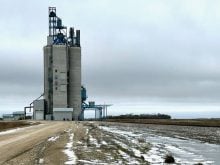A new barley variety is expected to be a hit with ranchers, organic producers and other low-input feed growers because it fares better than others when left to its own devices, says its breeder.
CDC Cowboy is a new two-row feed and forage barley line developed to perform well under less than ideal conditions.
“I gave it the name Cowboy because we selected it on the basis of it being for my cowboy friends in the southwest of Saskatchewan, southeast of Alberta in particular, but anywhere they might happen to be, as it’s a forage barley,” said Brian Rossnagel, a plant breeder at the Crop Development Centre in Saskatoon and developer of Cowboy.
Read Also

Internet of Things tapped for better emissions insights
Interconnected field sensor fleet allows better soil monitoring coverage and, hopefully, live insights on farm greenhouse gas emissions and nitrogen fertilizer application for farms.
He said the variety is ideal for ranchers who have little interest in growing grain but see it as necessary to feed their cattle. With CDC Cowboy, producers can basically “toss it in the ground, go away and then come back and harvest it.”
Dale Alderson, marketing manager for Western Canada with SeCan, said this two-row barley is unique in that it seems to do relatively better than other varieties under low input management, in lighter soils or in drier environments.
“The benefit of quick emergence, quick growth and quick canopy cover gives this line a role to play in feed barley production where inputs are reduced or timing of weed control is hard to be accurate,” Alderson said.
Seed trials have shown that Cowboy’s strengths lie in its high forage dry matter yield potential, its resistance to stem rust and smuts, its high test and kernel weights and its plump kernels.
The seed size impressed Wayne Dick, an organic producer from Guernsey, Sask., who has been growing and evaluating Cowboy for two years.
“A lot of times when you grow something under low inputs like that, you get a shrivelled, small kernel. It was a very nice, plump kernel, even under last year’s conditions with the frost and everything.”
Dick also liked the amount of forage it produced.
“I thought it had good height and definitely the leaf material on there was denser than the (CDC) McGuire I had it beside. I liked what I saw.”
This seed line handles drought well, said Rossnagel. In 2002, when there was drought, most of the entries in his field trials experienced yield losses of up to 50 percent, while Cowboy’s yield was reduced by 30 percent.
CDC Cowboy was also the top biomass producer for two years in all of the 10 test sites of the co-op forage trials across Western Canada, making it one of the best forage barleys available, said Rossnagel.
However, he cautioned forage producers not to use this line for hay because it has rough awns that can cause sores in cattle’s mouths. It is intended for silage, since the ensiling process softens the awns.
CDC Cowboy adapts well to most area of the Prairies and is designed to perform favourably under relatively stressful conditions, Rossnagel said. Even though it is strong-strawed, this tall barley might not work as well in areas that usually experience more growth or lodging than normal.
Dick is confident Cowboy will be a good fit with other organic and low input producers when it becomes commercially available.
“I was quite pleased with it last year. It’s a vigorous plant. … It grows well.”
CDC Cowboy is the latest variety of what Rossnagel refers to as “opportunistic” plant breeding. He said breeders don’t have funding to research the forage potential of cereals, but when a certain line looks different and might work for forage, they’ll pull it aside, test it, harvest it and if it still looks promising, the variety will be advanced through the trial process.
Alderson said producers won’t be able to purchase CDC Cowboy seed next year.














